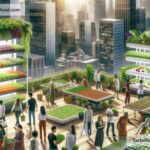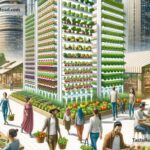The Future of Food and Urban Resilience: Building Stronger Cities for Tomorrow
The future of food and urban resilience is something that affects all of us. As cities grow larger and challenges like climate change become more serious, we need to think about how we produce, distribute, and consume food in ways that can support healthy communities while protecting the planet. Urban areas must adapt to these challenges by becoming more self-sufficient, sustainable, and resilient. Let’s explore how the future of food and urban resilience are connected and why it matters for everyone.
What is Urban Resilience?
Urban resilience is the ability of cities to bounce back from challenges like natural disasters, economic hardships, or social stresses. It’s about creating systems that can handle unexpected problems without falling apart. When thinking about resilience, food is a big part of the equation. Without reliable access to food, cities cannot function properly. By investing in food systems that are sustainable and adaptable, we can make our cities stronger.
Now more than ever, increasing urban resilience is critical. Climate change is already impacting agricultural production, and global supply chains can easily be disrupted. Whether it’s floods, droughts, or a pandemic, cities need to find ways to ensure their residents have access to nutritious food, no matter what happens.
The Current Challenges in Food Systems
The food system we rely on today faces many challenges. Most cities depend on food grown far away, transported from rural areas or other countries. This means that urban areas are vulnerable to disruptions—if something goes wrong, like rising fuel costs or extreme weather, the flow of food can be interrupted.
Additionally, agriculture as we know it today is not always environmentally friendly. Large-scale farming uses enormous amounts of water, pesticides, and fertilizers, which can harm ecosystems. Livestock farming is also a major contributor to greenhouse gas emissions. With a growing global population, feeding billions of people while protecting the environment is a tough task.
Another issue is food waste. It’s shocking to learn that roughly one-third of all food produced in the world is wasted—either thrown out or spoiled before it’s eaten. This wasted food not only costs money but also contributes to pollution and wastes valuable resources. Addressing food waste is one way to improve urban resilience and reduce environmental harm.
How Cities Are Rethinking Food
Cities around the world are already taking exciting steps to reshape their food systems and become more resilient. Let’s look at some innovative ideas and solutions:
Urban Agriculture
Urban farming is growing food right in the city, whether it’s on rooftops, in community gardens, or through vertical farming systems. By producing food locally, cities can reduce their reliance on faraway farms. Urban agriculture also uses less land and water than traditional farming, making it more sustainable.
For example, in cities like Singapore and New York, vertical farms produce vegetables in stacked layers indoors. These farms use LED lights and hydroponics (growing plants without soil) to save space and resources. Urban farms also help reduce “food miles,” the distance food travels to get to consumers, cutting emissions and ensuring freshness.
Smart Technology
Technology is playing a big role in shaping the future of food and urban resilience. Innovations like artificial intelligence (AI) and sensors are helping farmers grow crops more efficiently. Precision agriculture uses data to determine the best time to water or fertilize plants, reducing waste and boosting yields.
Apps and blockchain technology are also making supply chains more transparent, so consumers can know exactly where their food comes from. Smart refrigerators and apps can help households track expiration dates and reduce food waste.
Local Food Markets and Food Sharing
Cities are focusing on smaller-scale solutions that improve access to local, fresh produce. Farmers’ markets and direct-to-consumer models allow people to buy food that’s grown nearby, supporting local farmers and reducing dependence on large supply chains.
Food-sharing programs are also gaining popularity, where surplus food is distributed to those in need. This not only minimizes waste but also helps vulnerable communities.
Alternative Proteins
The way we think about protein is changing. Plant-based foods and lab-grown meat are becoming more common, offering sustainable alternatives to traditional meat. Producing plant-based protein requires fewer resources, while lab-grown meat eliminates the need for raising livestock, which contributes to emissions and deforestation. These alternatives can play a big role in feeding growing cities without harming the environment.
How This Builds Resilience
By focusing on local food production, reducing waste, using smart technology, and exploring innovative diets, cities can become less reliant on fragile global systems. These solutions make urban areas more adaptable to challenges like climate shocks, pandemics, and supply chain breakdowns. Resilient food systems also promote equality by ensuring everyone has access to nutritious food, reducing hunger and supporting public health.
What Can You Do as an Urban Resident?
Many of these solutions rely on people in cities taking action. Here are ways you can contribute:
– Grow your own food in small spaces like windowsills or balconies.
– Shop at local farmers’ markets to support nearby producers.
– Reduce food waste at home by planning meals and storing food properly.
– Try alternative proteins like plant-based burgers or stay mindful about sustainable eating.
Looking Ahead
The future of food and urban resilience is full of possibilities and challenges. By rethinking how we produce, consume, and share food, we can create strong cities that are prepared for whatever comes next. Together, governments, businesses, and individuals can build a future where everyone has access to safe, healthy food while caring for the environment. It’s an exciting journey, and everyone has a role to play.


